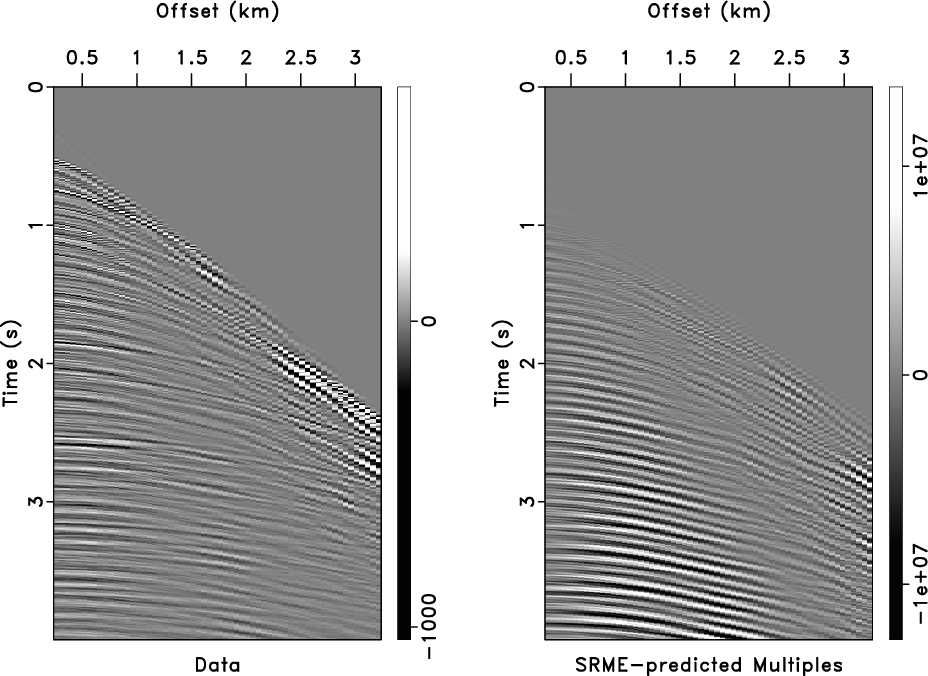|
|
|
|
Seislet-based morphological component analysis using scale-dependent exponential shrinkage |
Our second example is the separation of primaries and multiples for the field CMP gather shown in Figure 5 (Fomel and Guitton, 2006). In the case of signal separation, the mask operator ![]() becomes an identity.
The multiples are predicted using surface-related multiple elimination (SRME). Even though SRME fails to predict the correct amplitudes, however, the resulting prediction helps PWD to extract the dominant slopes of multiple events.
Before applying the seislet-based MCA method, it is important to point out that the iteratively reweighted least-squares (IRLS) method using the model precondition is another way for sparsity-enforced separation (Daubechies et al., 2010). Thus, we compared multiple removal by two different methods: seislet-based IRLS method and the proposed seislet-based MCA method. For comparison, the separated primaries and multiples using different methods are plotted in Figures 6 and 7. Visually, the seislet-based IRLS method and the seislet-based MCA method output similar primaries, which can also be seen clearly from the velocity scans of the primaries shown in Figure 8. To further confirm our conclusion, we draw the velocity scans of predicted multiples in Figure 9. The panels of velocity scan in Figures 8 and 9 demonstrate that using MCA, the primaries correctly correspond to high velocity part while the multiples are associated with low velocity part. Figure 9 shows that seislet-based MCA outperforms the seislet-based IRLS method in the locations A and B in the velocity scan panel due to the nice match of the corresponding semblance scan of the original data; at locations C and D, the energy of multiples obtained by seislet-MCA has less leakage, compared to the seislet-IRLS method. Note that the seislet-based MCA algorithm only uses 15 iterations to obtain the best separation effect, while the number of iterations for seislet-IRLS method is 1000. Therefore, seislet-based MCA is very efficient to demultiple.
becomes an identity.
The multiples are predicted using surface-related multiple elimination (SRME). Even though SRME fails to predict the correct amplitudes, however, the resulting prediction helps PWD to extract the dominant slopes of multiple events.
Before applying the seislet-based MCA method, it is important to point out that the iteratively reweighted least-squares (IRLS) method using the model precondition is another way for sparsity-enforced separation (Daubechies et al., 2010). Thus, we compared multiple removal by two different methods: seislet-based IRLS method and the proposed seislet-based MCA method. For comparison, the separated primaries and multiples using different methods are plotted in Figures 6 and 7. Visually, the seislet-based IRLS method and the seislet-based MCA method output similar primaries, which can also be seen clearly from the velocity scans of the primaries shown in Figure 8. To further confirm our conclusion, we draw the velocity scans of predicted multiples in Figure 9. The panels of velocity scan in Figures 8 and 9 demonstrate that using MCA, the primaries correctly correspond to high velocity part while the multiples are associated with low velocity part. Figure 9 shows that seislet-based MCA outperforms the seislet-based IRLS method in the locations A and B in the velocity scan panel due to the nice match of the corresponding semblance scan of the original data; at locations C and D, the energy of multiples obtained by seislet-MCA has less leakage, compared to the seislet-IRLS method. Note that the seislet-based MCA algorithm only uses 15 iterations to obtain the best separation effect, while the number of iterations for seislet-IRLS method is 1000. Therefore, seislet-based MCA is very efficient to demultiple.

|
|---|
|
srme
Figure 5. The field CMP data (left) and SRME predicted multiples (right). The amplitudes of SRME prediction needs to be corrected. |
|
|

|
|---|
|
signal
Figure 6. Separated primaries using seislet-IRLS (1000 iterations) and seislet-based MCA (15 iterations). |
|
|

|
|---|
|
nois
Figure 7. Separated multiples using seislet-IRLS (1000 iterations) and seislet-based MCA (15 iterations). |
|
|

|
|---|
|
vsignal
Figure 8. Velocity scan for primaries obtained by seislet-IRLS and seislet-based MCA (first two panels, from left to right). The velocity scan of original data is shown in the last panel for comparison. |
|
|

|
|---|
|
vnois
Figure 9. Velocity scan for multiples obtained by seislet-IRLS and seislet-based MCA (first two panels, from left to right). The velocity scan of original data is shown in the last panel for comparison. Seislet-based MCA outperforms seislet-based IRLS method in the locations A and B in the velocity scan panel due to the nice match of the corresponding semblance scan of the original data; at locations C and D, the energy of multiples obtained by seislet-MCA has less leakage, compared to seislet-IRLS method. |
|
|
|
|
|
|
Seislet-based morphological component analysis using scale-dependent exponential shrinkage |